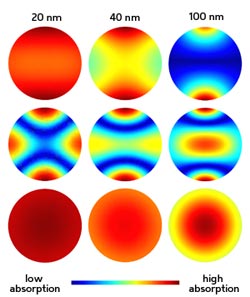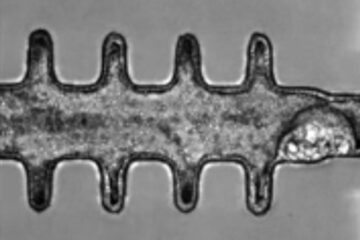Computer models show device size matters

The ‘in-plane’ ferromagnetic-resonance response of a magnetic nanostructure changes with device size —shown here in the simulation results by the rapidly varying colors. The ‘out-of-plane’ response, on the other hand, is relatively constant.<br><br> © 2014 A*STAR Data Storage Institute<br>
Scientists hope that patterning magnetic materials with nanometer-scale structures will help the development of non-volatile electronic memories with large storage capacities and no moving parts. So-called magnetoresistive random access memories are one example. But material properties at such tiny dimensions are not always the same as those of larger structures.
Kwaku Eason, Maria Sabino and their co-workers from the A*STAR Data Storage Institute, A*STAR National Metrology Centre and National University of Singapore have now modeled the changes in the characteristics of magnetic materials as devices are reduced in size to the nanoscale1.
The researchers focused their attention on modeling a powerful and widespread tool for characterizing magnetic materials called ferromagnetic resonance (FMR). FMR measures the absorption of microwave radiation by a thin sample. Knowing which microwave frequencies are absorbed the most can provide a number of key material properties. One such crucial property is the damping parameter, which is an indicator of how quickly a memory made from the magnetic material can store and release data.
The team employed a mathematical tool, known as the finite element method, to simulate a simple cylindrical nanodevice in all three dimensions. By calculating the energy levels of the device in an external magnetic field, the team could predict the FMR signal for devices of varying sizes.
The researchers compared their simulations to experimental data obtained on nanodisks made of a nickel–iron alloy, known as permalloy, and found good agreement for all device sizes. “Other groups have provided additional experimental results that further confirm the accuracy of our predictions,” says Eason.
The ability to predict the damping parameter of nanostructured magnetic materials is important because it is difficult to experimentally measure this property — partly because FMR signals from tiny targets are usually weak. Instead, researchers must study much larger devices and hope that the damping parameter is similar for nanostructures.
Recent experiments have conflicted on this point of scale. “One research group found from their experiments that device size does not matter in the damping measurement, while another group found that it does,” explains Eason. “We have resolved this dilemma: it turns out that they were both right.” Sabino adds: “The results were contradictory because of the different material properties.”
The simulations showed that the ‘in-plane’ magnetic properties are sensitive to the dimensions of the device, whereas the ‘out-of-plane’ properties are constant (see image).
“Contributing to a clear understanding of this effect is one of the most gratifying parts of this work,” says Eason.
The A*STAR-affiliated researchers contributing to this research are from the Singapore-based Data Storage Institute and the National Metrology Centre
Journal information
Eason, K., Sabino, M. P. R. G., Tran, M. & Liew, Y. F. Origins of magnetic damping measurement variations using ferromagnetic resonance for nano-sized devices. Applied Physics Letters 102, 232405 (2013).
Media Contact
All latest news from the category: Information Technology
Here you can find a summary of innovations in the fields of information and data processing and up-to-date developments on IT equipment and hardware.
This area covers topics such as IT services, IT architectures, IT management and telecommunications.
Newest articles

Solving the riddle of the sphingolipids in coronary artery disease
Weill Cornell Medicine investigators have uncovered a way to unleash in blood vessels the protective effects of a type of fat-related molecule known as a sphingolipid, suggesting a promising new…

Rocks with the oldest evidence yet of Earth’s magnetic field
The 3.7 billion-year-old rocks may extend the magnetic field’s age by 200 million years. Geologists at MIT and Oxford University have uncovered ancient rocks in Greenland that bear the oldest…

Mini-colons revolutionize colorectal cancer research
As our battle against cancer rages on, the quest for more sophisticated and realistic models to study tumor development has never been more critical. Until now, research has relied on…





















